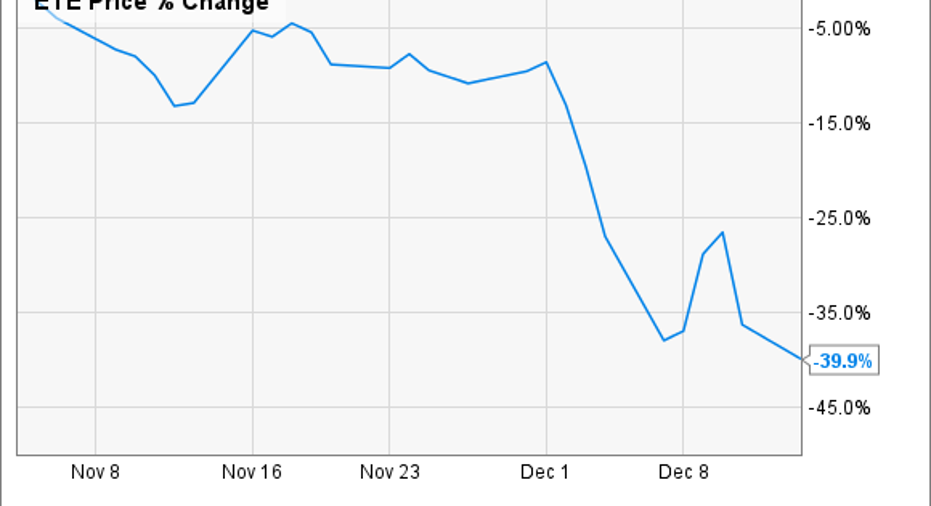Energy Transfer Equity, L.P.'s Worst Moves in 2015

With its unit price down 50% since the start of the year, it's pretty clear that 2015 has been a tough year for Energy Transfer Equity . While some of that had to do with the overall dour mood of the energy market, which spilled over into master limited partnerships, that wasn't the only storyline driving units lower. The company made a couple of questionable moves that certainly didn't help.
Levering upOne thing that MLPs aren't shy about doing is adding debt, most of which is used to fund growth projects. That being said, with the energy market in turmoil due to low oil prices, it's starting to impact that credit market's willingness to lend to energy-related companies. However, despite this growing unease, Energy Transfer Equity loaded up on debt, with a focus on issuing shorter-term debt.
When the company reported its second-quarter results in August, it detailed several recent accomplishments, including that it had borrowed $230 million on its revolving credit facility, which resulted in a leverage ratio, as defined by the credit agreement, of 2.93 times. Then, one quarter later, it noted that its borrowings had increased to $930 million, leading to a leverage ratio of 3.27 times. The concern here is that its short-term borrowings and leverage ratio are heading in the wrong direction at a time when the market is growing more concerned with these two energy company metrics.
More leverage on the wayThis steady increase in short-term debt and leverage is coming just before the company closes its step-change merger with Williams Companies . While I think that the merger itself is the best move Energy Transfer Equity made this year, there is one aspect of the deal that, in light of current market conditions, is the wrong move to be making. That move will see Energy Transfer Equity pay Williams Companies' investors up to $8 per share in cash with this cash outlay resulting in the company borrowing up to $6.05 billion. While Energy Transfer Equity originally offered an all-equity deal, that apparently wasn't good enough for Williams.
This cash component, however,could prove to be a problem down the road for two reasons. First, it significantly adds to Energy Transfer Equity's debt load, especially when adding in the debt it will assume from Williams Companies.
Data source: Energy Transfer Equity investor presentation.
That additional debt could weigh the company down in the future or limit its financial flexibility.
The other concern is the type of debt being used, which is a senior secured credit facility. The reason there is a concern here is because this is short-term debt, which has a unique set of risks. Topping that list is the fact that it will need to be termed out into longer-term debt in the future. That could prove to be a problem if interest rates rapidly rise or credit worries in the energy sector grow. Either risk could cause the company to have to pay a lot higher price for new long-term debt in order to pay down its credit facility.
A buyback gone badThe last of the less-than-stellar moves that the company made this year was to start repurchasing units even as it piles on more debt. The company noted last quarter that it had completed the repurchase $1.06 billion of its units under its $2 billion buyback program. The problem with this buyback is that instead of supporting its unit price, Energy Transfer Equity's units have fallen by about 40%since it detailed its progress on the buyback in its last earnings release:
To put this in perspective, the company has basically incinerated $400 million in cash in a little over a month via this buyback plan. Clearly, this wasn't the best use of this capital.
Investor takeawayDespite the fact that the energy market was growing weaker by the day, Energy Transfer Equity continued to borrow liberally. It's a move that could come back to haunt it if the credit market freezes up because short-term debt made up the bulk of it. Worse yet, even as it added debt to the balance sheet, the company spent a significant amount of money to buy back its units, only to see that cash incinerated by a market that has yet to stabilize. It's cash the company will wish it held on to if conditions continue to worsen.
The article Energy Transfer Equity, L.P.'s Worst Moves in 2015 originally appeared on Fool.com.
Matt DiLallo has no position in any stocks mentioned. The Motley Fool has no position in any of the stocks mentioned. Try any of our Foolish newsletter services free for 30 days. We Fools may not all hold the same opinions, but we all believe that considering a diverse range of insights makes us better investors. The Motley Fool has a disclosure policy.
Copyright 1995 - 2015 The Motley Fool, LLC. All rights reserved. The Motley Fool has a disclosure policy.



















